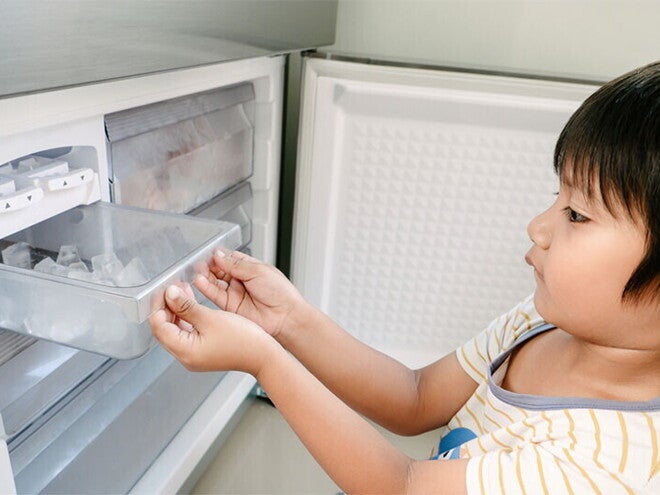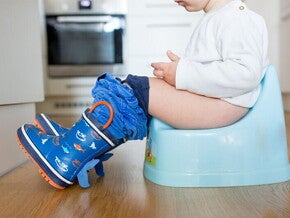
Does your child seem to tire much faster than their friends, or have you noticed a strange new habit like chewing on ice? These behaviors can be easy to miss, but they may be among the 5 weird signs of iron deficiency that go beyond obvious clues such as pale skin.
Before learning to spot these specific symptoms, it helps to understand what iron deficiency means and why it’s a big deal for your child's health.
Why Your Child's Iron Levels Are So Important
Iron is an essential mineral that helps red blood cells deliver oxygen throughout your child's body—fueling everything from their energy to their brain function. When iron stores run low, it's called iron deficiency. If it worsens, it can develop into iron-deficiency anemia (IDA) and lead to long-term health issues.
The World Health Organization confirms that severe cases can directly affect a child's motor and cognitive development, affecting their ability to interact socially, perform in school, and focus on tasks.
Filipino Kids Are at Risk
Iron deficiency is a serious problem for many Filipino children. The DOST-FNRI's National Nutrition Survey found that 25.3% of infants aged 6 to 23 months suffer from anemia
The causes of iron deficiency anemia include:
- Dietary gaps: A 2019 study published in Frontiers in Nutrition explains that while many Filipino meals are rich in plant-based foods, the type of iron in these foods (non-heme iron) is harder for the body to absorb.
- Picky eaters: Many children don't get enough iron-rich foods like meat, beans, and green leafy vegetables.
- Rapid growth: Toddlers and adolescents experiencing growth spurts may need more iron.
5 Weird Signs of Iron Deficiency in Kids
Now that you know why iron is essential, here are the surprising signs that could mean your child needs more of this mineral.
1. Strange cravings
One of the most unusual symptoms of iron deficiency is pica, a behavior where kids crave and eat unusual things that lack nutrition like ice or non-edibles, such as dirt and paper. While the exact reason this happens isn't fully understood, a 2023 review shows that treating pica with iron may stop these unusual cravings.
Pica is different from how babies and young toddlers put almost everything in their mouths. That's their typical way of exploring the world. So, pediatricians rarely diagnose pica in children younger than 2 years old.
2. Restless legs
A child with restless legs syndrome (RLS) gets an uncontrollable urge to move their legs. A preschooler might complain about creepy-crawly feelings in their legs, but this is trickier to spot in infants or young toddlers. Instead, you might notice they’re restless in bed, have trouble settling down, or show strong bedtime resistance.
The uncomfortable sensations of RLS are often linked to dopamine, a brain chemical that helps control muscle movement. Low iron levels can disrupt dopamine signals, leading to the urge to move.
A 2022 case report in the Journal of Clinical Sleep Medicine found that a two-year-old with RLS and sleep disturbances improved after treating an underlying iron deficiency.
3. Unusual fatigue and lack of energy

Is your toddler suddenly uninterested in play? Constant exhaustion, not just moodiness, can be a surprising sign of low iron.
If your active child gets exhausted constantly, it could be more than just a need for a nap. Without enough iron, the body can't efficiently carry oxygen to its tissues and muscles, depriving them of energy.
You may notice toddlers and preschoolers lacking interest in play, being more irritable than usual, or struggling to keep up with their friends' energy levels. In infants, this might appear as extreme fussiness, a lack of interest in their surroundings, and a poor appetite.
4. A swollen or sore tongue
In cases of extremely low iron, your child's tongue can become swollen, inflamed, and smooth, a condition called atrophic glossitis. Your preschooler might complain that their tongue hurts, but in younger children, you might just notice increased irritability during feeding or a new reluctance to eat.
Atrophic glossitis happens because a lack of iron causes the tongue to become inflamed, while also depleting myoglobin, the protein that keeps the tongue muscle healthy. Without enough myoglobin, the tiny bumps on the tongue, called papillae, can shrink, giving it a smooth or glossy appearance.
A 2024 literature review confirmed that changes to the tongue's surface are a known oral manifestation of iron deficiency anemia.
5. Noticeable hair loss
Finding more hair than usual on your child's brush or pillow can be alarming. While some shedding is normal, significant loss or brittle hair can be another unexpected sign of low iron.
When the body is low on iron, it prioritizes sending oxygen to essential organs, diverting it from less critical functions, such as hair growth. This can cause hair to become dry and fall out more easily. Addressing the effects of iron deficiency can often help restore your child's hair to its normal health.
Getting a Diagnosis: What to Expect at the Doctor's Office
If you've noticed any of these surprising signs, the next step is to schedule a visit with your pediatrician. To prepare for the appointment, don't forget to:
- Write down the specific signs and symptoms you noticed.
- List down what your child typically eats each day.
- Think of questions you want to ask your pediatrician.
During the visit, your doctor will likely conduct a physical exam to check for visible signs and may order a blood test to assess your child's iron levels accurately.
Boosting Your Child’s Iron Needs

A balanced diet with iron-rich foods like leafy greens, eggs, and meat helps prevent the effects of iron deficiency in children.
Here’s the recommended daily iron intake from the Philippine Department of Science and Technology - Food and Nutrition Research Institute (DOST-FNRI):
Daily Iron Intake for Children | ||
| AGE | MALE | FEMALE |
| 0 to 5 months | 0.4 mg a day | 0.4 mg a day |
| 6 to 11 months | 10 mg a day | 9 mg a day |
| 1 to 2 years | 8 mg a day | 8 mg a day |
| 3 to 5 years | 9 mg a day | 9 mg a day |
| 6 to 9 years | 10 mg a day | 9 mg a day |
| 10 to 12 years | 12 mg a day | 20 mg a day |
| 13 to 15 years | 19 mg a day | 28 mg a day |
| 16 to 18 years | 14 mg a day | 28 mg a day |
You can include a variety of these top 10 iron-rich foods in your family meals:
- Lean red meats (like beef and pork)
- Poultry (chicken and turkey)
- Fish
- Liver and other organ meats
- Eggs (especially the yolk)
- Beans and lentils (like monggo)
- Dark green leafy vegetables (like malunggay and kangkong)
- Tofu
- Iron-fortified cereals and bread
- Dried fruits like raisins
Help your child absorb iron better by pairing iron-rich foods with vitamin C sources. Check out this healthy meal planning guide to fill any nutrient gaps.
Your doctor might prescribe an iron supplement. Remember to follow the prescribed dosage, as excessive iron intake can be harmful. Ask your doctor about the best time to take an iron supplement and if your child should take it with food.
Knowing 5 weird signs of iron deficiency allows you to take proactive steps to ensure your child gets the nutrients they need for a healthy and energetic childhood.
Want to share nutrition tips? Join the ParentTeam Moms and Dads Facebook group to share your experiences and learn more about spotting the 5 weird signs of iron deficiency.
References
Al Nasser, Yasser, Ezzeldin Muco, and Ahmad J. Alsaad. "Pica." In StatPearls. Treasure Island, FL: StatPearls Publishing. Updated June 26, 2023. Accessed June 16, 2025. https://www.ncbi.nlm.nih.gov/books/NBK532242/
Anne Marie, U., J. Murererehe, M. Rehman, M. Chittilla, P. Uwambaye, and M. S. Razzaque. 2023. "Oral manifestations of iron imbalance." Frontiers in Nutrition 10: 1272902. https://doi.org/10.3389/fnut.2023.1272902
Bae, Hyoeun, Keun Tae Kim, Mi Hwa Heo, Young-Rok Do, and Yong Won Cho. 2021. "The prevalence and clinical characteristics of restless legs syndrome in patients with iron deficiency anemia in Korea." Journal of Clinical Sleep Medicine 17, no. 7: 1447–1452. https://doi.org/10.5664/jcsm.9230
Cedars-Sinai. "Iron-Deficiency Anemia in Children." Accessed June 16, 2025. https://www.cedars-sinai.org/health-library/diseases-and-conditions---pediatrics/i/iron-deficiency-anemia-in-children.html
Cleveland Clinic. "Does Iron Deficiency Cause Hair Loss?" Last reviewed April 21, 2022. Accessed June 16, 2025. https://health.clevelandclinic.org/im-low-in-iron-can-this-cause-me-to-lose-my-hair
Cleveland Clinic. "Restless Legs Syndrome." Last reviewed September 11, 2023. Accessed June 16, 2025. https://my.clevelandclinic.org/health/diseases/9497-restless-legs-syndrome
Dosman, C., M. Witmans, and L. Zwaigenbaum. 2012. "Iron's role in paediatric restless legs syndrome - a review." Paediatrics & Child Health 17, no. 4: 193–197. https://doi.org/10.1093/pch/17.4.193
Goyena, Eva A., Ma. Lynell V. Maniego, and Imelda Angeles-Agdeppa. 2020. "Determinants of Hemoglobin Status in Filipino Children and Women Population Based on a Nationwide Survey." Philippine Journal of Science 149, no. 3-A: 731-746. https://philjournalsci.dost.gov.ph/images/pdf/pjs_pdf/vol149no3a/determinants_of_hemoglobin_status_in_Filipino_children_.pdf
Mayo Clinic. "Iron deficiency in children: Prevention tips for parents." Last reviewed February 7, 2024. Accessed June 16, 2025. https://www.mayoclinic.org/healthy-lifestyle/childrens-health/in-depth/….
Nemours KidsHealth. "Pica." Medically reviewed by Yamini Durani. Last reviewed September 2023. Accessed June 16, 2025. https://kidshealth.org/en/parents/pica.html.
Trotti, L. M., and L. A. Becker. 2019. "Iron for the treatment of restless legs syndrome." The Cochrane Database of Systematic Reviews 1, no. 1: CD007834. https://pmc.ncbi.nlm.nih.gov/articles/PMC6353229/#CD007834-sec-0078




























